This post was last updated on June 27th, 2023
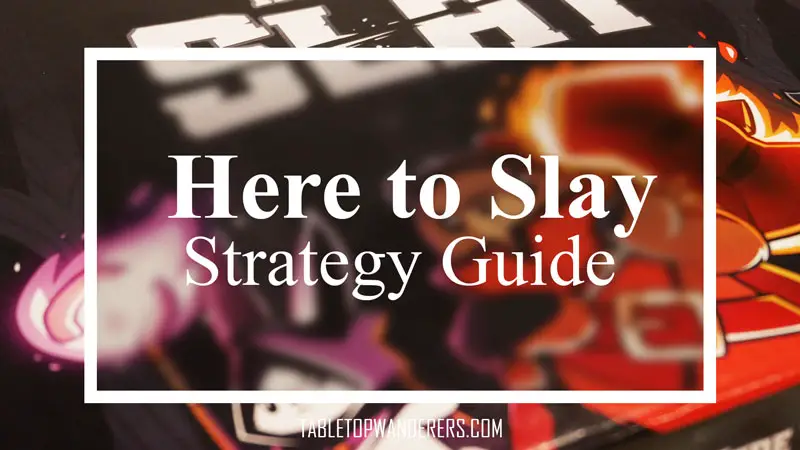
Does it make sense to write a Here to Slay strategy, since the game is (apparently) very simple?
As I stated in my Here to Slay review, the core mechanics of the game are very easy to learn, full stop.
Although, if you start to consider the actual numbers and statistics of the cards, it won’t come as a surprise how deeper the game in reality is.
The different number of card types, the different skills of the Party leaders and Heroes, the different strengths and skills of the Monsters, and so on, contribute to making your strategy a winning or a losing one.
This strategy guide will take into consideration the base game and the Druid+Warrior and Berserker+Necromancer expansions, which are the 2 most common (and affordable) expansions of the game.
Let’s learn together how to win at Here to Slay, or at least increase our chances!
- Here to Slay Strategy Guide – Core Concepts
- Here to Slay Strategy Guide – 8 Tips to Win
- #1 | Pick the right Party Leader
- #2 | Carefully choose the Monster you want to slay and the timing to attack it
- #3 | Modifier cards are fundamental
- #4 | Make good use of the elusive Cursed Items
- #5 | Protect your Heroes
- #6 | Keep an eye on opponents' cards and Party
- #7 | Don't be afraid to Challenge the opponents
- #8 | Keep the cards in your hand in a limited number & try not to stand out
- If you liked this post, you may also be interested in:
This post may contain affiliate links. If you click through and make a purchase, I will get a commission at no extra cost to you. See our Affiliate Disclosure.
Here to Slay Strategy Guide – Core Concepts
Core Concepts, here we go again.
I really love to write a quick overview of points before diving into the actual strategy guide, because it helps to clarify some concepts that might not be deeply explained in the 8-point list itself.
I did it for Tokaido and Hive strategies, and they were pretty useful.
Which path should you follow in order to win?
The very first thing to set in stone is to refresh ourselves on the 2 different ways of winning the game:
- Slay 3 Monsters.
- Have a Party with 6 different Hero classes.
You can either follow one of these paths “vertically” and go all in with that or you can follow both paths and choose the one to pursue towards mid-game.
Both options have pros and cons. I personally prefer to start broad and subsequently pick a path, because it gives me more freedom to adapt to the game dynamics.
This Here to Slay strategy guide is based on that, keeping both ways of winning viable until the end.
The number of each type of card is important
Here to Slay is a card game and as expected the number of cards for each type (Magic, Modifiers, Items, etc etc…) is very important when you plan a strategy.
Not all cards are in the main deck with the same percentage; some cards are much less than others, therefore let me share some numbers combining the base game and the 2 aforementioned expansions.
Base game + Warrior and Druid Expansion + Berserkers and Necromancers:
- Hero cards (80)
- Item cards (29)
- Magic cards (19)
- Modifier cards (31)
- Challenge cards (18)
This concept is fundamental to remember when it comes to choosing the right Party leader, due to the interaction some of them have with certain cards.
Party leaders aren’t equally strong and your chances to win also depend on who you choose
The Party leaders in the base version of the game are 6 and they all have unique skills:
- The Fist of Reason (Fighter) – each time you roll to Challenge, +2 to your roll.
- The Protecting Horn (Guardian) – each time you play a Modifier card on a roll, +1 or -1 to that roll.
- The Divine Arrow (Ranger) – each time you roll to Attack a Monster card, +1 to that roll.
- The Shadow Claw (Thief) – once per turn on your turn, you may spend an action point to pull a card from another player’s hand.
- The Cloaked Sage (Wizard) – each time you play a Magic card, Draw a card.
- The Charismatic Song (Bard) – each time you roll to use a Hero card’s effect, +1 to your roll.
In the Warrior and Druid expansion, the new Party leaders are two:
- The Piercing Howl (Warrior) – each time you roll, +1 to your roll for each Item card equipped to a Hero card in your Party.
- The Noble Shaman (Druid) – once per turn on each player’s turn, you may choose any player’s roll. -1 to that roll.
In the Berserker and Necromancer expansion, the new Party leaders are two:
- The Raging Manticore (Berserker) – each time you SLAY a Monster card, DRAW 2 cards.
- The Gnawing Dread (Necromancer) – once per turn on your turn, you may spend 2 action points to search the discard pile for a card and add it to your hand.
I’ll write an in-depth Party leaders tier list so I won’t spend much time on this topic here; just keep in mind that not all these leaders have the same strength, someone’s way better than others.
Here to Slay Strategy Guide – 8 Tips to Win
#1 | Pick the right Party Leader
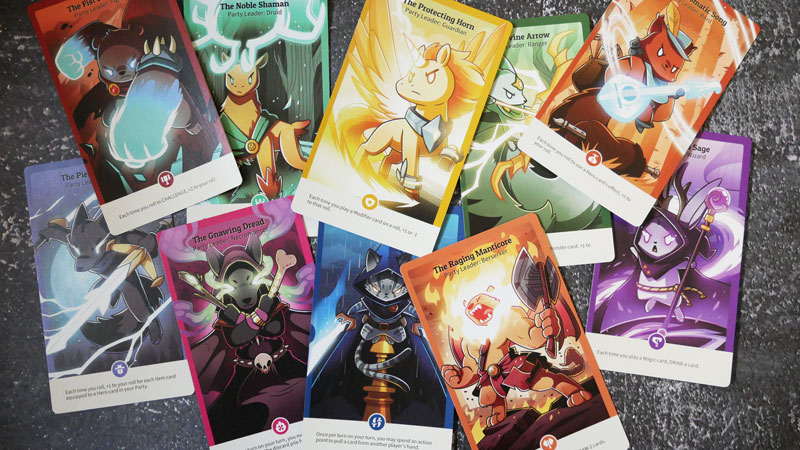
First and foremost, this is a very important choice you have to make before even starting to play.
In brief, this is my personal tier list of the Party leaders from the worst to the best:
- The Cloaked Sage (Wizard)
- The Divine Arrow (Ranger)
- The Raging Manticore (Berserker)
- The Fist of Reason (Fighter)
- The Protecting Horn (Guardian)
- The Shadow Claw (Thief)
- The Gnawing Dread (Necromancer)
- The Charismatic Song (Bard)
- The Piercing Howl (Warrior)
- The Noble Shaman (Druid)
#2 | Carefully choose the Monster you want to slay and the timing to attack it
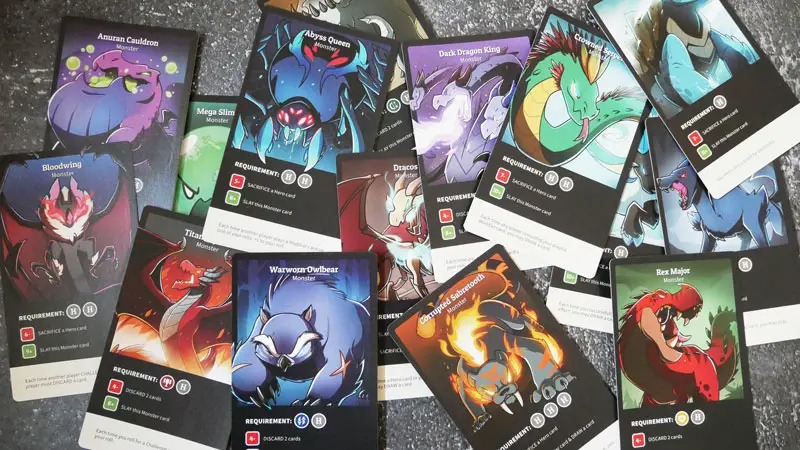
Similar to the Party leaders, each Monster is unique and some of them are stronger than others. Most importantly, there are some Monsters that synergize better with certain leaders.
In fact, after you chose the Party leader, it’s a good habit to try to first understand which Monster is worth the effort of slaying among the three at the centre of the table.
If my Party leader is The Cloaked Sage and the three face-up monster cards are Dracos, Orthus and Rex Major, I would 100% aim for Orthus first (each time you draw a Magic card, you may play it immediately) since its effect would synergize very well with my Wizard leader.
There are some Monsters that can work with every leader or Party composition and these are:
- Mega Slime
- Terratuga
- Muscipula Rex
- Bloodwing
- Reptilian Ripper
- Crowned Serpent
- Anuran Cauldron
- Corrupted Sabretooth
In order to get these passive effects, you have to slay the Monster though, so here comes the question – when should you attack a monster?
I think the best time to attack is when opponents have few cards, as it would be less likely to receive negative modifier cards on your rolls.
Also, depending on who you’re playing with, another good timing would be at the very beginning of the game when there aren’t any obvious winning paths and people are more likely to accept the fact you’re slaying a monster.
#3 | Modifier cards are fundamental
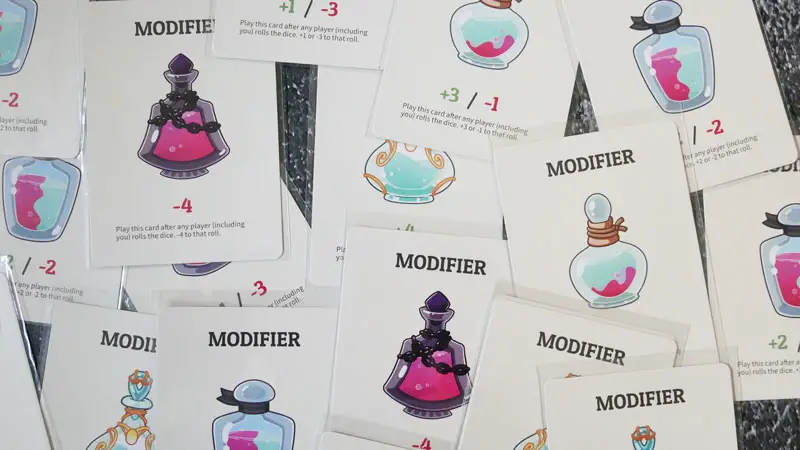
As in every game that relies on a certain amount of luck, anything that would tip the odds in your favour is always very important.
In this game, the function of Modifier cards is exactly that and therefore it’s crucial not to waste these powerful cards.
A quick premise before continuing; when it comes to playing modifier cards I usually follow this pattern:
- player A plays a card; - everyone plays any number of modifier cards to interfere if they want; - player A decides then to play his modifier cards; - perform the effect of that card.
Personally, there are some cases where playing the modifier card makes sense, for example:
- if playing a modifier would let you 100% slay a monster (which means no one else could interfere with the roll outcome).
- if it would stop a player from winning the game.
- and if it would stop a player from activating an effect that would exponentially decrease my chance of winning.
On the other hand, there are some cases where I wouldn’t play these cards, for example:
- playing a modifier card just to “pump” the roll result for the sake of it.
- if playing a modifier card wouldn’t change my chance of winning.
- and if it would prevent a player from getting a monster that I’m not interested in.
In general, I always try to be the last person to play modifier cards when possible.
#4 | Make good use of the elusive Cursed Items
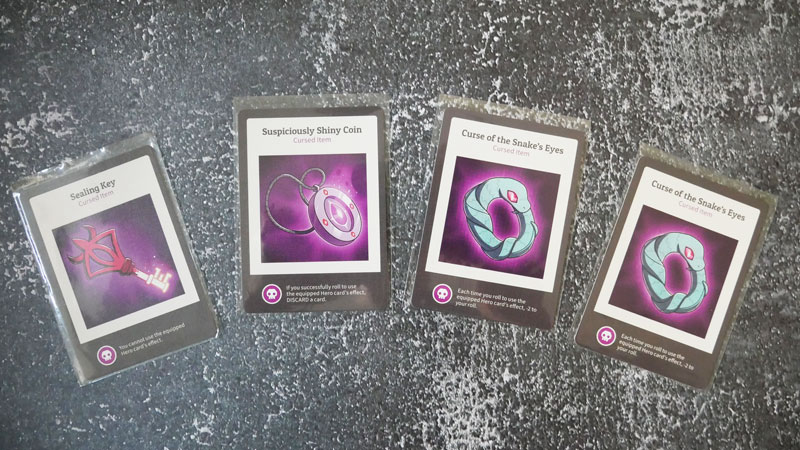
Items are third in the classific of the number of card types and among this category, you can find the Cursed Items which are the rarest in the game.
These cards are very powerful and if you put your hands on one of those, try to make good use of them.
My recommendation is to use them as soon as you can if an opponent has a strong Hero, in order to disrupt their strategy for a longer time and more importantly to avoid getting your cursed item stolen from you.
Try to find heroes for which it would make sense to apply a certain curse; for example, the Curse of the Snake’s Eyes works perfectly against those Heroes you know the opponents would use their ability whenever they could.
#5 | Protect your Heroes
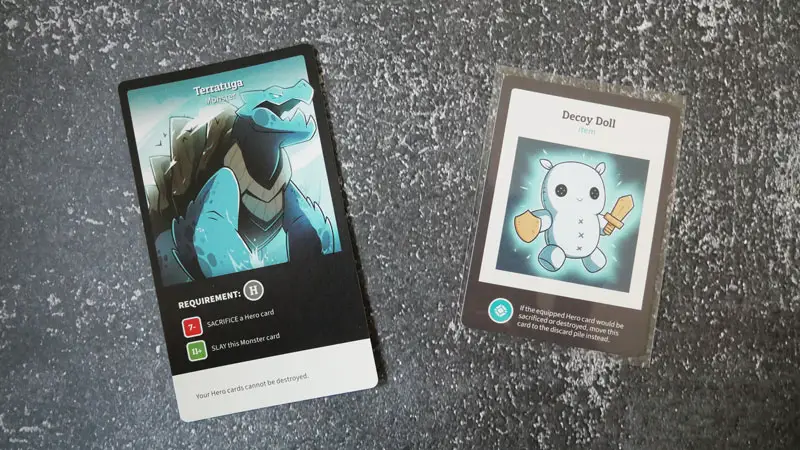
As you imagine Heroes are very important, in fact, most of the games seem to finish with a Full Party winner (this statement is based on personal experiences and on online discussions).
Try to protect your Heroes as much as you can from getting destroyed or stolen.
Honestly, it’s easier said than done because there are very few items/monsters that allow you to do it, but nevertheless, I think that’s better to have a chance of protection than no protection at all:
- Decoy Doll item – if the equipped hero card would be sacrificed or destroyed, move this card to the discard pile instead.
- Terratuga monster – your Hero cards can’t be destroyed.
At the same time you know that this is a game where Heroes come and go very often, so don’t get emotionally too attached to any of yours.
#6 | Keep an eye on opponents’ cards and Party
I personally find it very important to try to understand the strategy your opponents would likely follow.
If a player has already played 3 different Heroes in the early-mid game it’s likely that the player will try to win with a Full Party rather than slaying monsters.
On the other hand, if a player keeps trying to slay monsters, with or without much luck, the possibility that he’s trying to aim for a 3-slayed monsters victory is very high and you can play around it.
It’s crucial for you to always look at how many cards the other players have in their hands to try to predict their next moves.
#7 | Don’t be afraid to Challenge the opponents
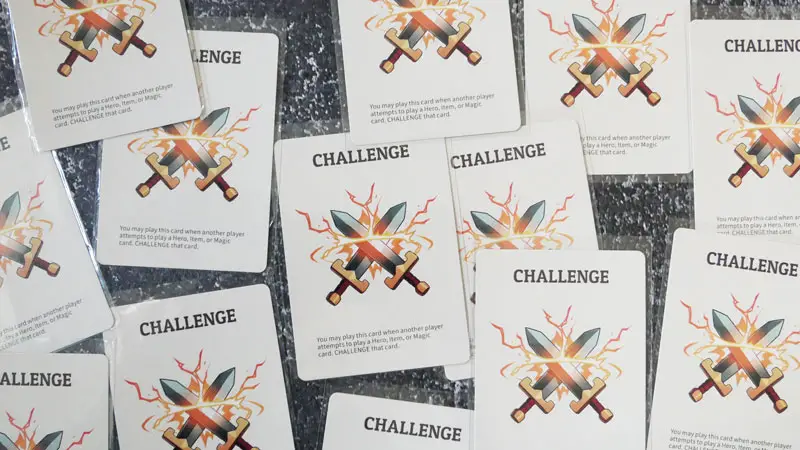
Challenge cards are an amazing tool for slowing down or stopping an opponent’ strategy.
It will still be a luck-based outcome since the fate of the challenge will be decided by dice rolls, but there’s an actual aspect of it that’s very overlooked and that is the possibility to play Modifier cards when you challenge an opponent.
As I wrote above I would 100% play a modifier card if that would increase my chance of victory or if it would prevent another player to win; so, challenging players opens up the possibility for you (and other players that might have your same interest of not losing) to play modifier cards and stop the “common” opponent.
#8 | Keep the cards in your hand in a limited number & try not to stand out
For the last point of my Here to Slay strategy I have something that could be applied to any game really.
When it comes to the everyone-against-everyone type of board games, it’s a good practice to try not to stand out in order to maximize the possibility of victory.
A player who’s the favourite to win since the early game is likely to get in trouble as all the opponents will do their best to stop him; therefore try to be smart and while doing steps forward towards victory, make some small steps backwards here and there to go unnoticed.
A good practice to apply the theory that I just wrote above, would be to try not to have too many cards in your hand all the time, as that would be very appealing and will likely attract other players looking to steal cards from someone.
You don’t want to be THAT someone!